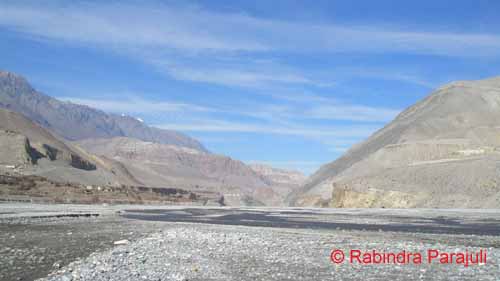General Information
Mustang,
also called the “Himal Pariko Jilla (District beyond the Himalayas)”, lies north
to the gigantic Annapurna-Dhaulagiri massif. People from low land called it as “Thak
Khola”; meaning – the land of Thakalis (Gurung Communities). The region
represents an extension of the Tibetan Platue and characterized by extremely
dry climate. The Annapurna (8091m average sea level) and Dhaulagiri (8167 m
asl) screens the summer monsoon, hence the rainfall is very scarce.
Some people
named the valley as a ‘desert of the Himalayas’. But ecologically it is being characterized
as an ARID zone and the flora recognized as Tibetan elements. The vegetation is
of the steppe type with domination of Caragana spp., Lonicera spp., Juniperus
spp., Rosa spp. etc. Tree species are limited to only Populus and Salix. Apples
tree are also found booming in private orchards.
Politically,
traditionally and even culturally (I think) the whole Mustang valley is divided
into 2 major regions; the Upper Mustang (popularly called the Lo-Manthang) and
the Lower Mustang. Kaligandaki river is the only river-system originated from Mustang. The river is famous in Hindu religion because we can find Ammonites/Shaligram (one of the various forms of Lord Bishnu - the Protector).
Lo-manthang
is the northern part of the Mustang extended towards north from Kagbeni up to the
border of Chinese Autonomous Region – the Tibet. The area is designated as a
restricted zone by the Department of Immigration, Government of Nepal. To my
knowledge, it is because the area has its particular culture/traditions, has
been ruling by the local King since centuries, and also because of being an
open border area with Tibet. It is mandatory to have an especial entry permit to
visit Lo-Manthang. The fee is quite a bit high. One person should pay at least US$
500 to enter the area and this works for 10days. For each extra day need to pay
US$ 50/day. The Department of Immigration only issues the permit. I haven’t yet
been to Upper Mustang. I would love to go and will write in detail if I get
chance to visit.
 |
| Dhaulagiri range - a major summer monsoon barrier ; as seen towards south from the Jomsom (the HQ of Mustang) |
 |
| A Landscape showing Cushion forming Caragana - Lonicera vegetation and Mt. Dhaulagiri on distant |
 |
| A landscape of Mustang showing the gorge carved by Kaligandaki river ; taken on 21st of November. |
 |
| Kaligandaki River and the lower part of Lo-Manthang, where we can find Ammonites easily |
It
is much easier to trek on the Lower Mustang. But a permit is must for foreigners.
The permit provisions are as:
Permit Procedure and Regulations:
Entry Fee (Per Person) to visit Annapurna
Conservation Area (ACA):
For SAARC Nationals: Nepali Rupees 200.
For other Nationals (other than SAARC countries): Nepali Rupees 2,000.
For SAARC Nationals: Nepali Rupees 200.
For other Nationals (other than SAARC countries): Nepali Rupees 2,000.
Note:
Entrance fee not
required for children less than 10 years of age.
Trekkers visiting
multiple Conservation Areas will require obtaining individual Entry Permits for
each Conservation Area.
Two passport size
photographs are required while applying for each Entry Permit.
Terms and Conditions:
This Entry Permit
is valid for single entry only and is non refundable, non-transferable. The
permit holder can enter the designated places within the Conservation Area.
Person entering
the Conservation Area shall abide by the National Park and Wildlife
Conservation Act, 2029 B.S. (1973) and the Regulations made under this Act.
This Entry Permit
must be carried during the entire trip and should be shown if concerned
personnel of the Conservation Area want to check it.
Entry permits to
Annapurna Conservation Area (and Manaslu Conservation Area as well) will only
be issued from the following Entry Permit Counters listed below. Entry Permits
will not be issued from any check posts along the trekking routes of the
Conservation Areas. Therefore, all are requested to obtain an Entry Permit
before entering the Conservation Areas. However, under special circumstances,
Entry Permit may be issued from the check posts along the trekking route upon a
payment of 100% additional charge.
Entry Permits
available at the following locations:
Kathmandu: Nepal Tourism
Board , Bhrikutimandap, Kathmandu (for Annapurna & Manaslu)
Opening hours Sunday to Saturday except on public holidays in Kathmandu: 9 am – 5 pm
Opening hours Sunday to Saturday except on public holidays in Kathmandu: 9 am – 5 pm
Pokhara: Nepal Tourism
Board, Tourist Service Centre, Pardi Damside (for Annapurna only)
Opening hours Sunday to Saturday except on public holidays in Pokhara: 10 am – 5 pm
Opening hours Sunday to Saturday except on public holidays in Pokhara: 10 am – 5 pm
Download Entry
Permit Application Forms:
A. Annapurna
Conservation Area (for Organized Groups)
B. Annapurna Conservation Area (for Individual Trekkers)
B. Annapurna Conservation Area (for Individual Trekkers)
For further information please
contact:
NTNC, Kathmandu: info@ntnc.org.np
NTNC-ACAP, Pokhara: info@ntnc-acap.org.np
Source of permit procedures and regulations: http://www.ntnc.org.np/trekking-annapurna-and-manaslu-information-and-entry-permit-forms
NTNC, Kathmandu: info@ntnc.org.np
NTNC-ACAP, Pokhara: info@ntnc-acap.org.np
Source of permit procedures and regulations: http://www.ntnc.org.np/trekking-annapurna-and-manaslu-information-and-entry-permit-forms
No comments:
Post a Comment